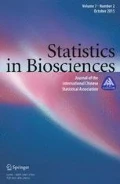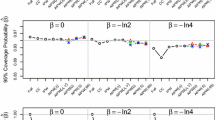Abstract
We consider the estimation of a nonparametric smooth function of some event time in a semiparametric mixed effects model from repeatedly measured data when the event time is subject to right censoring. The within-subject correlation is captured by both cross-sectional and time-dependent random effects, where the latter is modeled by a nonhomogeneous Ornstein–Uhlenbeck stochastic process. When the censoring probability depends on other variables in the model, which often happens in practice, the event time data are not missing completely at random. Hence, the complete case analysis by eliminating all the censored observations may yield biased estimates of the regression parameters including the smooth function of the event time, and is less efficient. To remedy, we derive the likelihood function for the observed data by modeling the event time distribution given other covariates. We propose a two-stage pseudo-likelihood approach for the estimation of model parameters by first plugging an estimator of the conditional event time distribution into the likelihood and then maximizing the resulting pseudo-likelihood function. Empirical evaluation shows that the proposed method yields negligible biases while significantly reduces the estimation variability. This research is motivated by the project of hormone profile estimation around age at the final menstrual period for the cohort of women in the Michigan Bone Health and Metabolism Study.
Similar content being viewed by others
References
Bartosik LP, Lajoie G, Sugar L, Cattran DC (2001) Predicting progression in IgA nephropathy. Am J Kidney Dis 38:728–735
Breslow N (1974) Covariate analysis of censored survival data. Biometrics 30:89–99
Cox DR (1972) Regression models and life-tables. J R Stat Soc, Ser B 34:187–220 (with discussion)
Cox DR (1975) Partial likelihood. Biometrika 62:269–276
Kalbfleisch JD, Prentice RL (2002) The statistical analysis of failure time data, 2nd edn. Wiley, New York
Lindstrom MJ, Bates DM (1988) Newton–Raphson and EM algorithm for linear mixed-effects models for repeated-measures data. J Am Stat Assoc 83:1014–1022
Little RJA, Rubin DB (2002) Statistical analysis with missing data, 2nd edn. Wiley, New Jersey
Reich HN, Troyanov S, Scholey JW, Cattran DC, for the Toronto Glomerulonephritis Registry (2007) Remission of proteinuria improves prognosis in IgA nephropathy. J Am Soc Nephrol 18:3177–3183
Rosenblatt M (2002) Random processes, 2nd edn. Springer, New York
Schumaker L (1981) Spline function: basic theory. Wiley, New York
Shen X, Wong WH (1994) Convergence rate of sieve estimates. Ann Stat 22:580–615
Song PX-K (2007) Correlated data analysis: modeling, analytics and applications. Springer, New York
Sowers MR, Zheng H, McConnell D, Nan B, Harlow SD, Randolph JF Jr (2008a) Estradiol rates of change in relation to the final menstrual period in a population-based cohort of women. J Clin Endocrinol Metab 93:3847–3852
Sowers MR, Zheng H, McConnell D, Nan B, Harlow SD, Randolph JF Jr (2008b) Follicle stimulating hormone and its rate of change in defining menopause transition stages. J Clin Endocrinol Metab 93:3958–3964
Stone CJ, Hansen MH, Kooperberg C, Truong YK (1997) Polynomial splines and their tensor products in extended linear modeling: 1994 Wald memorial lecture. Ann Stat 25:1371–1470
Susarla V, Van Ryzin J (1980) Large sample theory for an estimator of the mean survival time from censored samples. Ann Stat 8:1002–1016
Zhang S, Lin X, Raz J, Sowers M (1998) Semiparametric stochastic mixed models for longitudinal data. J Am Stat Assoc 93:710–719
Zhou S, Shen X, Wolfe DA (1998) Local asymptotics for regression splines and confidence regions. Ann Stat 26:1760–1782
Author information
Authors and Affiliations
Corresponding author
Rights and permissions
About this article
Cite this article
Lu, X., Nan, B., Song, P. et al. Longitudinal Data Analysis with Event Time as a Covariate. Stat Biosci 2, 65–80 (2010). https://doi.org/10.1007/s12561-010-9021-2
Received:
Accepted:
Published:
Issue Date:
DOI: https://doi.org/10.1007/s12561-010-9021-2




